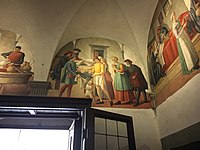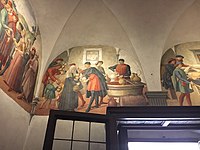
San Martino ai Monti, officially known as Santi Silvestro e Martino ai Monti, is a minor basilica in Rome, Italy, in the Rione Monti neighbourhood. It is located near the edge of the Parco del Colle Oppio, near the corner of Via Equizia and Viale del Monte Oppio, about five to six blocks south of Santa Maria Maggiore.

Sant'Anna dei Lombardi,, and also known as Santa Maria di Monte Oliveto, is an ancient church and convent located in piazza Monteoliveto in central Naples, Italy. Across Monteoliveto street from the Fountain in the square is the Renaissance palace of Orsini di Gravina.
Charitable institutions attached to churches in Rome were founded right through the medieval period and included hospitals, hostels, and others providing assistance to pilgrims to Rome from a certain "nation", which thus became these nations' national churches in Rome. These institutions were generally organised as confraternities and funded through charity and legacies from rich benefactors belonging to that "nation". Often also they were connected to national "scholae", where the clergymen were trained. The churches and their riches were a sign of the importance of their nation and of the prelates that supported them. Up to 1870 and Italian unification, these national churches also included churches of the Italian city states.

The Loggia del Bigallo is a late Gothic building in Florence, region of Tuscany, Italy. It stands at the corner of Piazza San Giovanni and via Calzaioli; tradition holds the site near the Baptistry of Florence was donated by a benefactor.
Giuseppe Antonio Caccioli was an Italian painter of the Baroque period.

Andrea del Sarto was an Italian painter from Florence, whose career flourished during the High Renaissance and early Mannerism. He was known as an outstanding fresco decorator, painter of altar-pieces, portraitist, draughtsman and colorist. Though highly regarded during his lifetime as an artist senza errori, his renown was eclipsed after his death by that of his contemporaries, Leonardo da Vinci, Michelangelo and Raphael.

Palazzo Gherardi is a 15th-century building in the Santa croce quarter of Florence, Tuscany, in central Italy. Its main façade is on Via Ghibellina 88, while to the right it faces Via dei Pepi.

The Chiesa della Santissima Trinità dei Pellegrini is a Roman Catholic church located on Via dei Pettinari #36 In the rione of Regola of central Rome, Italy. It stands a block away from the Palazzo Spada on Via Capo di Ferro, while a few blocks away on the Via dei Pettinari stands the Ponte Sisto.

The Church of San Pellegrino in Vaticano is an ancient Roman Catholic oratory in the Vatican City, located on the Via dei Pellegrini. The church is dedicated to Saint Peregrine of Auxerre, a Roman priest appointed by Pope Sixtus II who had suffered martyrdom in Gaul in the third century. It is one of the oldest churches in the Vatican City.
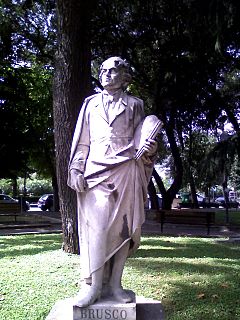
Paolo Gerolamo Brusco or Girolamo Brusco was a prolific Italian painter active in Liguria. He was also nicknamed Bruschetto.

San Giuseppe is a Baroque architecture, Roman Catholic church building located on Via San Giuseppe, near Piazza Santa Croce, in central Florence, region of Tuscany, Italy, and is one of two churches and an oratory in the city dedicated to St Joseph.

The Basilica of San Giovanni Maggiore is a church in Largo San Giovanni Maggiore in central Naples, Italy.

San Carlo Borromeo or San Carlo is a Baroque style, Roman Catholic church located in Turin, region of Piedmont, Italy. It mirrors the adjacent church of Santa Cristina and faces the Piazza San Carlo. The arrangement recalls the twin churches of Santa Maria dei Miracoli (1681) and Santa Maria in Montesanto (1679) facing the Piazza del Popolo in Rome.
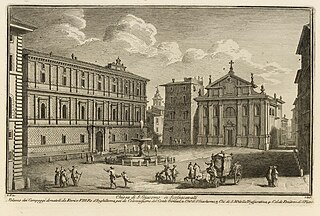
San Giacomo Scossacavalli was a church in Rome important for historical and artistic reasons. The church, facing the Piazza Scossacavalli, was built during the early Middle Ages and since the early 16th century hosted a confraternity which commissioned Renaissance architect Antonio da Sangallo the Younger to build a new shrine. This was richly decorated with frescoes, painted by mannerist artist Giovanni Battista Ricci and his students. The church was demolished in 1937, when Via della Conciliazione was built and the piazza and central part of the Borgo rione were demolished. Many decorative elements still exist, since they were preserved from demolition.
Giuseppe Servolini, also known as Sorbolini, (1748–1834) was an Italian painter and engraver active mainly in Florence.

The Complesso di San Firenze is a 17th-century Baroque-style building, consisting of a church, palace, and former oratory, located on the southeast corner of the saucer-shaped piazza of San Firenze, located in the quartiere of Santa Croce in central Florence, region of Tuscany, Italy. The buildings were commissioned by the Oratorians of Saint Philip Neri.

San Benedetto is a small, Roman Catholic former parish church, then oratory, located in a piazza of the same name just off the piazza of the Duomo of Florence, region of Tuscany, Italy.

Monastero delle Murate is a former Benedictine convent on Via Ghibellina in Florence, Italy. For about a hundred years, from 1883 to 1985, it was the men's prison in Florence, after which the detainees were transferred to Sollicciano and other facilities. Since the 21st century, it has served as a restaurant and meeting places, with additional apartments, bars, restaurants and shops. The religious community dates to 1370 when 12 women became voluntarily reclusive in a shack by the second pillar of the Ponte Rubaconte, praying and living on alms in extremely difficult conditions. Given the growth in the number of sisters, in 1424, Giovanni de 'Benci, who lived nearby, financed the construction of a new, larger monastery near the walls, called the Most Holy Annunciation and St. Catherine. The monastery was renovated and expanded for the first time in 1471, following a fire, and then in 1571, after a flood. Supporters included Lorenzo de' Medici. Also in 1509 Caterina Sforza was buried in the monastery.

The Assisi Diocesan Museum, in the city of Assisi, was founded in 1941 by bishop Giuseppe Placido Niccolini to preserve the most important works of art of the Assisi Cathedral and of several oratories of Assisi's confraternities. The museum is located underneath the piazza of the cathedral and has a collection consisting of about 300 works of which 100 are on display, exhibited in the museum's nine sections.
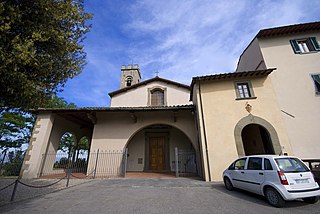
San Martino a Gangalandi is a Roman Catholic parish (pieve) church in the Gangalandi neighborhood of Lastra a Signa in the region of Tuscany, Italy. It is located via Leon Battista Alberti. Adjacent to the church is a small Museo Vicariale displaying some works of art.


